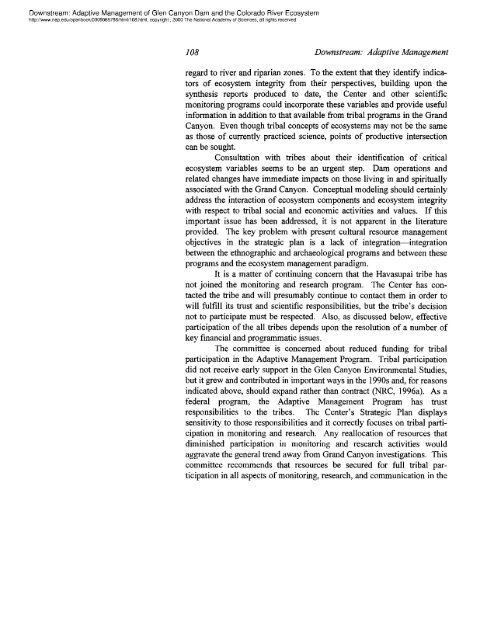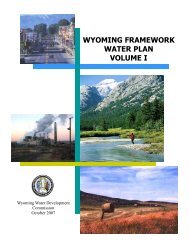Glen Canyon Dam adaptive management program. - Living Rivers
Glen Canyon Dam adaptive management program. - Living Rivers
Glen Canyon Dam adaptive management program. - Living Rivers
Create successful ePaper yourself
Turn your PDF publications into a flip-book with our unique Google optimized e-Paper software.
Downstream: Adaptive Management of <strong>Glen</strong> <strong>Canyon</strong> <strong>Dam</strong> and the Colorado River Ecosystem<br />
http://www nap.edu/openbook/0309065798/html/108.html, copyright, 2000 The National Academy of Sciences, all rights reserved<br />
108 Downstream: Adaptive Management<br />
regard to river and riparian zones. To the extent that they identify indicators<br />
of ecosystem integrity from their perspectives, building upon the<br />
synthesis reports produced to date, the Center and other scientific<br />
monitoring <strong>program</strong>s could incorporate these variables and provide useful<br />
information in addition to that available from tribal <strong>program</strong>s in the Grand<br />
<strong>Canyon</strong>. Even though tribal concepts of ecosystems may not be the same<br />
as those of currently practiced science, points of productive intersection<br />
can be sought.<br />
Consultation with tribes about their identification of critical<br />
ecosystem variables seems to be an urgent step. <strong>Dam</strong> operations and<br />
related changes have immediate impacts on those living in and spiritually<br />
associated with the Grand <strong>Canyon</strong>. Conceptual modeling should certainly<br />
address the interaction of ecosystem components and ecosystem integrity<br />
with respect to tribal social and economic activities and values. If this<br />
important issue has been addressed, it is not apparent in the literature<br />
provided. The key problem with present cultural resource <strong>management</strong><br />
objectives in the strategic plan is a lack of integration~integration<br />
between the ethnographic and archaeological <strong>program</strong>s and between these<br />
<strong>program</strong>s and the ecosystem <strong>management</strong> paradigm.<br />
It is a matter of continuing concern that the Havasupai tribe has<br />
not joined the monitoring and research <strong>program</strong>. The Center has contacted<br />
the tribe and will presumably continue to contact them in order to<br />
will fulfill its trust and scientific responsibilities, but the tribe's decision<br />
not to participate must be respected. Also, as discussed below, effective<br />
participation of the all tribes depends upon the resolution of a number of<br />
key financial and <strong>program</strong>matic issues.<br />
The committee is concerned about reduced funding for tribal<br />
participation in the Adaptive Management Program. Tribal participation<br />
did not receive early support in the <strong>Glen</strong> <strong>Canyon</strong> Environmental Studies,<br />
but it grew and contributed in important ways in the 1990s and, for reasons<br />
indicated above, should expand rather than contract (NRC, 1996a). As a<br />
federal <strong>program</strong>, the Adaptive Management Program has trust<br />
responsibilities to the tribes. The Center's Strategic Plan displays<br />
sensitivity to those responsibilities and it correctly focuses on tribal participation<br />
in monitoring and research. Any reallocation of resources that<br />
diminished participation in monitoring and research activities would<br />
aggravate the general trend away from Grand <strong>Canyon</strong> investigations. This<br />
committee recommends that resources be secured for full tribal participation<br />
in all aspects of monitoring, research, and communication in the
















